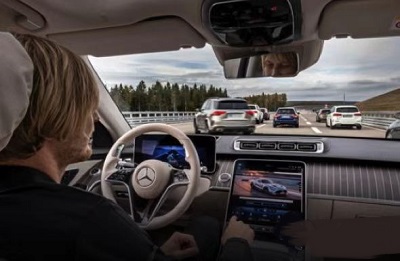The world’s first Mercedes-Benz won the international certification of conditional autonomous driving (L3) system
The world’s first
The rapid development of intelligent technology, autonomous driving technology has always been the focus of the automotive industry.
Mercedes-Benz has carried out extensive road tests in global markets such as China and the United States many years ago

Mercedes-Benz won international certification of L3 system
Historical coincidence?
The world’s first conditional autonomous driving (L3) system international certification was obtained by the inventor of the automobile.
Recently, the Mercedes-Benz L3 autonomous driving system passed the strict technical regulations of the German Federal Motor Vehicle Administration (KBA) and became the world’s first automobile company to obtain the UN-R157 certification.
The way paved
The approval of this regulation has paved the way for Mercedes-Benz to implement autonomous driving in various markets around the world under the premise of complying with the laws and regulations of various countries.
With the rapid development of intelligent technology, autonomous driving technology has always attracted the attention of the automotive industry.
At present, the intelligent classification of automobiles in the world is mainly formulated by the National Highway Traffic Safety Administration under the US Department of Transportation (National Highway Traffic Safety Administration) and SAE International, which are mainly divided into L1, L2, and L3. , L4, L5 five levels.
L3 automatic driving
Among them, L3 level automatic driving is conditional automation. Under certain conditions, the system completes all driving operations, and the driver provides an adaptive response according to the system request. The use of L3 autonomous driving systems needs to pass the certification of technical approval regulations.
The relevant technical regulations have come into effect in early 2021 and will be implemented in Europe subsequently.
Thanks to the deep integration of multiple radars, sensors and high-precision positioning systems, Mercedes-Benz’s Smart Pilot System (Drive Pilot) can reach a maximum speed of 60, the speed of km/h enables the L3 conditional autopilot mode.
In this driving mode, the driver can conduct online shopping or check e-mails on the central display, and can also contact colleagues or watch movies through the in-vehicle mobile office system.
In terms of actual driving, after the driver activates the intelligent pilot system, the system maintains or adjusts the speed and distance according to the settings, controls the car in the current lane stably, and drives with reference to the planned route, real-time road conditions and traffic signs.
The system can also respond to unexpected traffic conditions in a timely manner by independently completing operations such as avoiding or braking and steering in the lane.
Intelligent Pilot System
Based on multiple sensors, the intelligent pilot system can be equipped with additional sensors according to the safety requirements of conditional autonomous driving, including: lidar, rear windshield camera and microphone (especially used to detect special service vehicle police lights Blue light and other special signals), as well as the wheel well humidity sensor.
In addition to sensor data, the intelligent pilot system can also receive road shapes, routes, traffic signs, and abnormal traffic incidents (such as accidents or road construction) information through digital high-definition maps, and update these data through back-end connections.
The Mercedes-Benz S-Class with the optional intelligent pilot system is also equipped with redundant steering, braking and on-board electronic control systems. Even if any one of these systems fails, the car can still maintain its mobility, ensuring that the driver is always available take over the car safely.
If the driver fails to take over the car within the effective takeover time limit due to serious health problems and other reasons, after repeated emergency warnings, the system will control the car to gradually slow down until it is at a standstill, and the hazard warning lights will be lit at the same time.
Once the vehicle stops, the Mercedes-Benz emergency call system will be activated immediately, and the doors and windows of the car will be automatically unlocked to facilitate the entry of ambulance personnel.
In Germany, the first Mercedes-Benz S-Class sedans equipped with an intelligent pilot system will be delivered to customers in the first half of 2022, and the new EQS models will also be equipped with lithium power batteries and an intelligent pilot system.

Over the years, we have been working hard to realize the beautiful vision of autonomous driving. Based on the lidar system, we have developed this innovative technology that brings customers a unique luxury experience and enriches the customer’s journey experience.
Mercedes-Benz has now obtained approval from relevant authorities and has become the first manufacturer in Germany to provide mass-produced vehicles equipped with conditional autonomous driving systems.
Daimler AG and Mercedes-Benz AG board members, responsible for R&D and Markus Schäfer, the chief technology officer of the procurement business, said, “This is a milestone breakthrough that once again proves our ability to innovate in the field of autonomous driving, which will lead a new round of change.
In 135 years of automotive history, For the first time, vehicles can take over driving tasks under certain conditions. At the same time, with this approval, Germany will continue to play a pioneering role in the field of autonomous driving. We are deeply honored for this.”
Globally extensive road tests
Mercedes-Benz has launched extensive road tests in global markets such as China and the United States many years ago. Mercedes-Benz plans to provide an intelligent pilot system for busy road traffic on the 13,191 kilometers of highways across Germany in the initial stage.
Once other markets have formulated relevant legal frameworks for conditional autonomous driving, especially allowing drivers to use autonomous driving modes, the system will also be gradually promoted in a targeted manner.
In order to transform to a software-driven and emission-free future, Daimler’s Supervisory Board recently signed a plan to invest more than 60 billion euros in Mercedes-Benz from 2022 to 2026. Daimler said in a statement that the company’s goal is to be at the forefront of electric vehicle production and software.
Mercedes-Benz plans to achieve full electrification by the end of 2030, and the key to achieving this goal is to strictly prioritize future investments—mainly focusing on electric vehicles.
At this moment, passing the certification of the world’s first conditional L3 autonomous driving system has become another important milestone for Mercedes-Benz on the road to autonomous driving.
In the future, Mercedes-Benz will continue to make the interior of the car a “third space” of life through continuous technological innovation and application, which has attracted attention from all walks of life.





